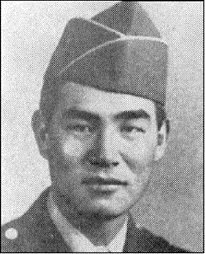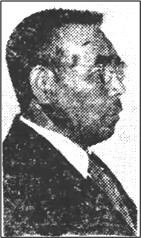
Sadaichi Kohara
Private First Class
442nd Regimental Combat Team
3rd Battalion, K Company
Sadaichi Kohara was born on March 8, 1923, in Honolulu, Oahu, Territory of Hawaii. He was the son of Keiichi and Soyo (Yasuda) Kohara. Keiichi came to Hawaii in 1906 from Oshima in Yamaguchi Prefecture, Japan. In 1910, he was single and working on a copra plantation in Kailua. Soyo was also from Yamaguchi Prefecture. She died in 1927 at the age of 38. Sadaichi had older sisters, Omiyo (born 1915), E. Itsuye (born 1918), and brother Masami (born 1921).
Wally, as Sadaichi was known, was educated at Waialae School, Aiea Elementary and Intermediate Schools, and Waipahu Intermediate School. He graduated from Aiea Independent (Dokuritsu) School on June 1, 1939. At the commencement ceremony, he presented the class gift of a globe. In the 1940 Federal Census, he was age 17 and he and brother Masami were living with their uncle and aunt, Fukumatsu and Kikuyo Yamaguchi, on Kamehameha Highway in Waimalu. He was unemployed. His father was a widower, living with his daughter Itsuye on Oili Road in Kahala, and the owner of his own painting business.
Kohara registered for the draft on June 30, 1942, at Local Board No. 9, August Ahrens School in Waipahu. At the time, he was employed by Five Star Companies as a service station attendant at the Underground Fuel Storage, at Red Hill. His father, who lived on Oili Road in Kahala, was listed as his point of contact. He was 5’5” tall and weighed 122 pounds.
Sadaichi Kohara enlisted in the U.S. Army in Waipahu on March 23, 1943. His civilian occupation was “Attendant, filling station.” He was sent with the other recruits to “Boom Town,” the tent city at Schofield Barracks. They were given a farewell aloha ceremony by the community on March 28 at Iolani Palace. On April 4, the new soldiers left on the S.S. Lurline for San Francisco enroute to Camp Shelby, Mississippi. After basic training, Wally Sadaichi was assigned to 3rd Battalion, K Company.
After months of training, the 442nd left Camp Shelby for Camp Patrick Henry, Virginia, on April 22, 1944. They shipped out to the Mediterranean Theater of Operations in a large convoy of troop ships on May 2, and arrived in Naples, Italy, on May 28.
Kohara participated in the Rome-Arno Campaign, entering combat at Suvereto on June 26. After fighting north up the Italian peninsula, the 442nd was sent to France to join in the Rhineland-Vosges Campaign. On September 26 and 27, Wally was among the 442nd men as they were loaded aboard light assault boats in Naples that shuttled them to the waiting Navy transports – Thurston, Dickman, Chase, and Henrico. At precisely 12:00 p.m. on the 27th, they sailed for France, arriving in Marseilles on September 30.
After a week at a staging area near Septèmes, just outside Marseilles, the Combat Team was moved north to the Vosges Mountains about 500 miles away. The 3rd Battalion was transported by train – an assortment of “40×8” boxcars, the last of the 442nd to arrive into the assembly area at Charmois-devant-Bruyères at midnight on October 13.
Kohara was in the battles that captured the towns of Bruyères and Belmont, and the Rescue of the Lost Battalion. During the action in the Vosges, he was wounded. After recovering from his wounds for several months, he returned to his unit in February 1945, where they were stationed in the Nice and Sospel area of southern France for the Rhineland-Maritime Alps Campaign. After months in France, the 442nd was ordered again to Italy.
Pfc. Kohara sailed with the 442nd from Marseilles on March 20-22, 1945, to Italy for participation the Po Valley Campaign.
The Combat Team arrived at their staging area in Pisa on March 25. Their arrival was a closely-held secret as their mission was to crack the western anchor of the enemy’s Gothic Line. They left on March 28 for a bivouac at San Martino, near the walled city of Lucca. This move was made in absolute secrecy under cover of darkness. While in San Martino, they spent their time in training.
On April 3, the 3rd Battalion marched to a forward assembly area in the small mountain town of Azzano on Mount Cavallo, again in darkness. The following two weeks saw the Combat Team steadily move north, taking the enemy’s heavily defended fortifications on one mountain peak after another.
By the third week of April, the Combat Team was in the vicinity of Fosdinovo and Mount Nebbione, which was the hub of the German defenses and fiercely defended. This was the last dominant terrain before the vital road center of Aulla. Third Battalion was probing the enemy defenses on Mount Nebbione from every possible angle, but were consistently beaten back. The men were weary after climbing up and down 3,000-foot peaks for two weeks without much rest.
On April 20, Sadaichi was a member of a patrol that encountered entrenched German troops. During the ensuing firefight, Private First Class Sadaichi Kohara was killed in action. The hospital admission card for April 1945 states that he was wounded in the abdominal/pelvic area and was a battle casualty.
Private First Class Sadaichi Kohara was interred in the U.S. Military Cemetery at Granaglione, Italy, Plot C, Row 3, No. 315. On May 30, 1945, his family held a memorial service for him at the Nishi Hongwanji temple on upper Fort Street in Honolulu at 10:30 a.m. He was survived by his father, sister Itsuye, and brother Masami.
For his military service, Private First Class Sadaichi Kohara was awarded the Silver Star Medal, Bronze Star Medal, Purple Heart Medal with one bronze oak leaf cluster, Good Conduct Medal, American Campaign Medal, European-African-Middle Eastern Campaign Medal with four bronze stars, World War II Victory Medal, Distinguished Unit Badge, and Combat Infantryman Badge. Sadaichi was awarded the Congressional Gold Medal on October 5, 2010, along with the other veterans of the 100th/442nd Regimental Combat Team. This is the highest Congressional Civilian Medal.
Kohara’s leadership and fighting spirit earned him a Silver Star Medal for his actions in the fight that took his life. The citation, dated October 9, 1945, reads:
Headquarters, 92d Infantry Division, General Orders No. 97
…to Sadaichi Kohara…for conspicuous gallantry and intrepidity in action against the enemy while serving with Company K, 3d Battalion…on 20 April 1945, in Italy. Having advanced within 200 yards of the enemy, a patrol was suddenly pinned down by two hostile machine guns. Leaving his men under cover, Private First Class Kohara advanced 10 yards before locating the two machine gun emplacements. Unable to advance through the crossfire, the patrol was pinned down by this fire for a half an hour before he and a rifleman could advance 50 yards. Finally reaching a vantage point 20 yards from the first emplacement, Private First Class Kohara threw a hand grenade and killed three of the foe. The two men were withdrawing when the rifleman was hit by a sniper. Private First Class Kohara dragged him back to safety with his patrol. He returned to attempt to knock out the remaining machine gun but the resistance was too great. Calling for 81-mm. mortar fire, he immediately crawled 10 yards forward and adjusted the fire until the hostile weapon was neutralized. Later, while adjusting mortar fire on another hostile machine gun position, he was mortally wounded. His outstanding courage exemplifies the finest traditions of the American Soldier.

In the January 22, 1946, edition of the Honolulu Advertiser, it was reported that the Silver Star Medal was presented to Sadaichi’s father, Keiichi Kohara (Photo – left),, by Col. Earl D. Weed, Chaplain, in a brief ceremony at the Kohara home, 402 Oili Road. The presentation was made on behalf of Lt. Gen. Robert C. Richardson Jr., Commanding General, Army Forces, Middle Pacific.
In 1948, the remains of Americans buried overseas began slowly to return to the US, if the family so wished. As a result, on April 21, 1949, Private First Class Sadaichi Kohara arrived home. The USAT Sergeant Jack J. Pendleton brought back 134 men, arriving at Honolulu Harbor’s Kapalama Basin. There were hundreds of family and friends present to attend the dockside memorial service. Secretary of Hawaii Oren E. Long officiated, the 264th Army Band played, and military Chaplains participated. The caskets were stored in the Army mausoleum at Schofield Barracks pending funeral arrangements at the National Memorial Cemetery of the Pacific at Punchbowl.
On May 31, 1949, Memorial Day, the Aiea Community Association dedicated a Memorial Plaque to the 14 local servicemen who died during World War II. Sadaichi Kohara’s name was among those listed on the plaque.
On May 29, 1994, Sadaichi Kohara was among the 14 Aiea war dead who were honored during a service under the auspices of the Aiea United Methodist Church at the Aiea War Memorial located at Aiea Library on Moanalua Road. His brother Masami recalled for the newspaper that Sadaichi was “a good kid. The only thing was that he was a little shy.” The speaker at the service was Ronald Oba, past president of the 442nd RCT Veterans Club.
Original Biography prepared by Americans of Japanese Ancestry World War II Memorial Alliance, and provided courtesy of Japanese American Living Legacy (http://www.jalivinglegacy.org/).
Researched and rewritten by Nisei Veterans Legacy, 7/31/22021.
